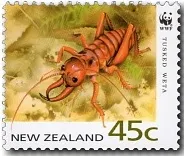For a small country, New Zealand is well endowed with fascinating wildlife. Yet a disproportionately high number of our native species are at risk of disappearing; some are rare, others endangered or vulnerable and many are regionally threatened. For many, time is running out. Reassuringly, though, a global awareness has helped turn the tide for some species.
This issue, with each stamp incorporating the World Wide Fund for Nature (WWF) logo, depicted 13 of New Zealand's rare and threatened species. Twelve appeared on the block of four stamps, which were also available in sheets of single stamps. Another, the Mercury Island tusked weta, was issued in a stamp booklet format. This small collection of birds, plants, animals, insects and sea life are representative of the hundreds of New Zealand species at risk.
The Stamps (Used)
45c - Yellow-eyed penguin with Hector's dolphin and the New Zealand fur seal.
The Yellow-eyed penguin is known as 'Hoiho' or 'noise shouter' to the Maori, and its plight has been well publicised in recent times. As a result, numbers are slowly increasing on New Zealand's mainland. Probably the world's rarest penguin, it can be found in small areas of the Otago, Canterbury and Southland coastline.
Hector's dolphin is the only dolphin confined to New Zealand waters. Its numbers are low, estimated at only between 3,000 and 4,000.
The New Zealand fur seal was almost hunted to extinction but has recovered since hunting was banned almost 80 years ago. Today about 50,000 New Zealand fur seals live and breed in New Zealand waters.
45c - Blue duck together with the taiko and the Mt Cook lily.
Blue ducks pair for life and stay together all year round, requiring about a kilometre of river for breeding. However, their natural habitat has been drastically reduced in recent years.
The Chatham Island taiko is regarded as one of the world's rarest seabirds. It has a white breast and belly and black-brown upper parts. Only a few birds are thought to exist.
Also known as the giant buttercup the Mount Cook lily reaches 1 to 1.5 metres and produces large white flowers each 4 to 5 centimetres across.
45c - Rock wren with giant snail and Hamilton's frog.
Often seen hopping and running about rocks and boulders, the rock wren is a tiny alpine bird that lives in the mountains of the South Island. Distinctive with its bright yellow flank, this weak flier is one of many of our native birds under threat.
The giant snail is a forest dweller, usually active at night and taking 15 years to reach maturity.
New Zealand has three endemic species of frog; all are ancient relics of a primitive stock. Hamilton's frog is the rarest and is only found in two locations - on Stephens Island in Cook Strait and Maud Island in the Marlborough Sounds.
45c - Kaka with the Chatham Island pigeon and the giant weta.
A member of the parrot family, the kaka is a browny-grey bird with startling colourful underwing feathers. Whilst it was very common when European settlers first arrived in New Zealand, today its future is far from secure, due to - amongst other factors - introduced predators.
The New Zealand pigeon, a large handsome bird, thrives on the main islands. but on the Chatham Islands the subspecies has all but disappeared.
Giant wetas are possibly the most ancient and primitive part of New Zealand's biological history. They deserve the 'giant' tag because at full maturity they are twice as heavy as a mouse.
45c - Booklet Stamp - Tusked Weta.
The tusked weta, discovered in 1970, is found only on one tiny island in the Mercury group off the east coast of the Coromandel Peninsula. At 85 millimetres it is the largest of New Zealand's ground burrowing wetas but only the male has the large tusks which grow out of its jaws.
The 45c weta appeared in a booklet format of 10 stamps. Above the booklet cover
can be seen while below is the sheet containing the 10 stamps.
A larger view for the four stamp block showing how they become a single picture.
The First Day Covers.

45c - Yellow-eyed penguin with Hector's dolphin and the New Zealand fur seal.
Special First Day Cover. Notice the cave weta cancel.

45c - Blue duck together with the taiko and the Mt Cook lily.
Special First Day Cover.
45c - Rock wren with giant snail and Hamilton's frog.
Special First Day Cover.
45c - Kaka with the Chatham Island pigeon and the giant weta.
Special First Day Cover.
Full issue First Day Cover featuring the special weta cancel.
Technical information
| Date of Issue: |
9 June 1993
|
|---|---|
| Designer: |
Donna McKenna, Wellington, NZ
|
| Printer: |
Sheet stamps: Leigh-Mardon, Australia; Booklet stamp: Southern Colour Print, Dunedin
|
| Stamp Size: |
Sheet stamps: 40mm x 28mm; Booklet Stamp: 30mm x 25mm
|
| Sheet Size: |
100 stamps per sheet; Ten stamps per booklet
|
| Process: |
Lithography
|
| Perforation Gauge: |
Sheet Stamps: 14 x 14.25; Booklet Stamp: 13.25 x 13.75
|
| Paper Type: |
Peterborough Paper Convertors, red phosphor coated, unwatermarked
|
Some of the images in this post were used with permission from the illustrated catalogue of StampsNZ
You can visit their website and On-line Catalogue at, http://stampsnz.com/
Information for this post came from.












We appreciate your engagement with our content. To ensure a respectful and constructive community, please take note of the following:
- No Spam, Please: We do not tolerate spammy or promotional comments. Any such comments will be promptly removed.
- Moderation in Place: All comments are moderated to maintain a positive and inclusive environment. Please be patient, as it may take a little time for your comment to appear.
- Sign In with Google: To comment, please sign in using your Google account. This helps us maintain the integrity of our community and allows for better interaction.